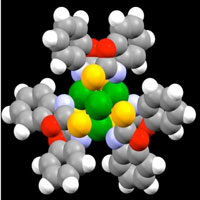 Researchers have demonstrated a new technique that could engineer the band gap needed to improve the performance of semiconductors for next-generation electronics such as optoelectronics, thermoelectrics, and sensors.
Researchers have demonstrated a new technique that could engineer the band gap needed to improve the performance of semiconductors for next-generation electronics such as optoelectronics, thermoelectrics, and sensors.
Thursday, August 20, 2020
Two-dimensional electronics get an atomic tune-up
 Researchers have demonstrated a new technique that could engineer the band gap needed to improve the performance of semiconductors for next-generation electronics such as optoelectronics, thermoelectrics, and sensors.
Researchers have demonstrated a new technique that could engineer the band gap needed to improve the performance of semiconductors for next-generation electronics such as optoelectronics, thermoelectrics, and sensors.
A quantum thermometer to measure the coldest temperatures in the universe
 Physicists have proposed a thermometer based on quantum entanglement that can accurately measure temperatures a billion times colder than those in outer space.
Physicists have proposed a thermometer based on quantum entanglement that can accurately measure temperatures a billion times colder than those in outer space.
Trapping and controlling light at the interface of atomically thin nanomaterials
 Scientists propose a new method to confine light in an atomically thin graphene layer by leveraging topological phenomena that occur at the interface of specially designed nanomaterials.
Scientists propose a new method to confine light in an atomically thin graphene layer by leveraging topological phenomena that occur at the interface of specially designed nanomaterials.
Graphene sensors find subtleties in magnetic fields
 Researchers used an ultrathin graphene 'sandwich' to create a tiny magnetic field sensor that can operate over a greater temperature range than previous sensors, while also detecting miniscule changes in magnetic fields that might otherwise get lost within a larger magnetic background.
Researchers used an ultrathin graphene 'sandwich' to create a tiny magnetic field sensor that can operate over a greater temperature range than previous sensors, while also detecting miniscule changes in magnetic fields that might otherwise get lost within a larger magnetic background.
Researchers create nanoclusters that mimic biomolecules
 Researchers discovered a way to bind and stack nanoscale clusters of copper molecules that can self-assemble and mimic these complex biosystem structures at different length scales. The clusters provide a platform for developing new catalytic properties that extend beyond what traditional materials can offer.
Researchers discovered a way to bind and stack nanoscale clusters of copper molecules that can self-assemble and mimic these complex biosystem structures at different length scales. The clusters provide a platform for developing new catalytic properties that extend beyond what traditional materials can offer.
Creating the best TV screen yet with blue perovskite quantum dots
 There are many things quantum dots could do, but the most obvious place they could change our lives is to make the colours on our TVs and screens more pristine.
There are many things quantum dots could do, but the most obvious place they could change our lives is to make the colours on our TVs and screens more pristine.
Subscribe to:
Posts (Atom)
